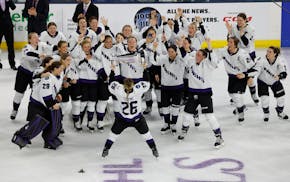High school basketball players stop playing when the buzzer sounds. They head to the locker room for halftime or they line up to shake hands.
This season, they can't believe everything they hear.
A change in the rules requires a change in behavior. The 35-second shot clock is required for all boys and girls high school basketball games this season, and just because that buzzer sounds doesn't mean it's the end of a half or a game.
It's just one of the effects of the Minnesota State High School League's decision to mandate the shot clock starting in 2023-24. Other effects will show on the bench, at the scorer's table, in strategy and, most important, in games when a stalling tactic might have been used in the past.
Even fast-paced teams that won't ever come close to running out the shot clock will have to deal with it because that buzzer will sound as their opponent runs out of time and forces up a shot.
Maple Grove girls players "so ingrained to stop on the buzzer" did just that in a season-opening, 68-50 victory at Wayzata, coach Mark Cook said.
"The buzzer went off, and our girls were kind of looking around," Cook said. "And I'm like, 'Just keep playing. Go. It's still going.'"
What, and who, will change?
Hayfield has had a shot clock for four years and has used it for nonconference home games.
"And it never goes off on us," Hayfield girls coach Kasey Krekling said. "I don't think the new shot clock era's going to mess up our game too much. We don't try to hold it for 30 seconds ever anyway."
But some teams do. Gone are the days of holding the ball for the final minutes of close games and forcing opponents to foul to stop the clock.
"You have to play it out," Cook said. "Good teams that play good defense are going to get rewarded for that."
Randy Misegades, the Henning boys coach, activities director and the Section 6A coaches representative for the Minnesota Boys Basketball Coaches Association, recalled that his 2019 state champion team essentially held the ball for the last four minutes of a 60-58 victory over Parkers Prairie in the section final.
"I think it's a good change," Misegades said. "You just have to keep playing the game, instead of watching kids shoot free throws the last handful of minutes."
Gary Revenig, Monticello activities director, MSHSL board member and a basketball official for more than 30 years, said he thinks the game will be more "run and gun."
"I think it's going to open up the game, and you'll probably see some higher scores," Revenig said.
You might see some panic, too, but maybe only for a while.
"Even when it gets under 10, initially last year I think kids were kind of freaking out," said Misegades, whose Henning team used the shot clock last season, along with the entire Park Region Conference. "'I'm almost to the end of the shot clock.' And in reality, 10 seconds in basketball is a long time. You have more time than you think."
Changing the game plan
Other effects on strategy will be more subtle but will be plentiful.
Tom Critchley Jr., in his 32nd year coaching basketball and his fourth leading the Big Lake boys team, said his team will look to disrupt possessions and force teams to hurry.
"You want to be solid for that first 10, 15 seconds and then put the other team in the spot where they have to realize that there is a clock and rush them into some shots," Critchley said.
Cook, also executive director of the Minnesota Girls Basketball Coaches Association, anticipates seeing more three-quarter-court zone presses, trying to make teams spend eight or nine seconds getting the ball up the floor.
Teams will need a menu of inbounds plays to run when the shot clock is low. "We can't run something where we inbound it and then set three screens because we don't have that kind of time," Cook said.
Wise use of timeouts will be necessary for those moments when the clock can't be allowed to expire, Critchley said. And teams still must consider fouling to stop the clock, because sometimes letting 35 seconds tick off is too costly.
Cook said he and his staff have coached JV players who will be on the bench during varsity games to start counting aloud when the shot clock hits 10 to help their teammates.
Clock management
The first step, and not a small one, was for schools to install shot clocks. Because that's done on the main court doesn't mean it's done on secondary courts; Cook said Maple Grove's back gym has no shot clock, so a timer and a coach counting down serve in practice.
Schools also have to position an additional person at the scorer's table to run the clock.
Misegades is ready at Henning with a group of shot-clock operators, for 13 home games for the boys team and 13 more for the girls team. For schools to find a group of people capable and willing to run the shot clock "is going to be a little bit of a challenge," Misegades said. "But it's the same for everybody."
The MSHSL put together a training video, which Revenig said all shot-clock operators were required to watch. "I'm sure a few people will probably be nervous their first time doing it, and then it's like, 'Hey, it's not so bad,'" he said.
Even those who used the shot clock last season are in for a change. Last year, if the shot clock was reset, it always went to 35 seconds. This season, the clock will reset to 20 seconds in some instances. Game officials, already a stressed group because of low numbers, will be tasked with monitoring whether the shot clock is properly set.
The Lake Conference also used the shot clock last season, and before Maple Grove and Wayzata played, Cook and Trojans coach Julie Stewart chatted about it. Stewart told Cook their teams would barely notice the clock because of their styles of play.
"And she was right," Cook said. "I think I heard the shot clock horn go off one time. It just doesn't change the game a lot … for teams that play a certain style. For other teams, it will."

Frost fire up over the chance to finish off Ottawa and celebrate PWHL title at home this time

Twins head on a road trip that's big on mileage and rife with complications

Reusse: A closer study of the Wolves at their absolute best reveals the value of Randle

Timberwolves unveil X-factor against Oklahoma City

